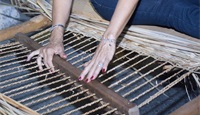
Applicant
Kapouti Community Council
Communities Concerned - Bearers of the element:
Kapouti Community Council, Kalo Chorio - Kapouti Refugee Association, “Free Kapouti” Youth Refugee Association and people who know and carry on the craft of mat-weaving.
Domain of Intangible Cultural Heritage:
Traditional craftsmanship
Date of inscription:
2015
Geographical location and range of the element:
The reed-mat was made by the women from the occupied village of Kapouti, situated 7 km north-east of the town of Morphou and numbering around one thousand inhabitants back in 1974. To the north of the village flows the Aloupos River whereas to the south it is the Ovgos River. A reed named “floudi” grows in the natural small ponds which are formed in these two rivers and this was the raw material for making the mat. It is said that a similar hand-woven article was also made with a different type of loom in Akrotiri, Limassol, using the outer layer of the reed called “samadji”.
Brief Description:
According to witness accounts, the craft of mat-weaving and of the special loom is a very old one and was passed on from one generation to the next up until 1974 when the village inhabitants were displaced. The entire family was involved in the making of these mats: men would cut and transport the reeds, women would weave them and children would assist in the process. Mat-weaving requires special knowledge about the plant’s behavior and properties (the “floudi” reed) as well as experience and skills in building the loom and the various artifacts. As the Kapouti inhabitants were associated with this craft it was necessary for their community to continue practising it even after 1974 although under new conditions due to the new surroundings and modern needs.
The production of the mats would begin very early in the morning. First they would assemble the loom and set it up in such a way so that the two beam edges on the side of the weaver would rest on a fixed point to provide resistance. Then the weaving of the mat would begin first by creating the frame. In the beginning the weaver would sit on the floor on top of some cloths or a pillow with her legs under the loom. As the mat was becoming longer, she would place a plank on the loom resting on the side beams and she would sit on this plank. As the weaving continued she would advance the plank.
Reed-mats have various uses, such as trays or racks for spreading different kinds of products to dry in the sun (e.g. trahanas, olives, wheat and others). They were also used as underlying mattresses or on roofs of traditional houses or other premises instead of wood or wicker-mats. Finally, it is worth noting that the Ottomans used to wrap their dead in the reed-mats before burial, as the body was not supposed to come into direct contact with the soil.